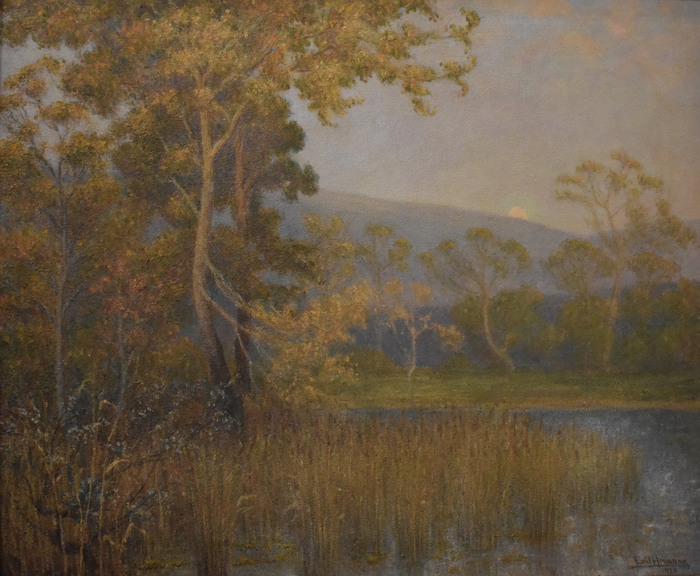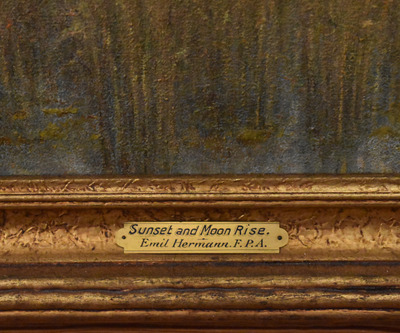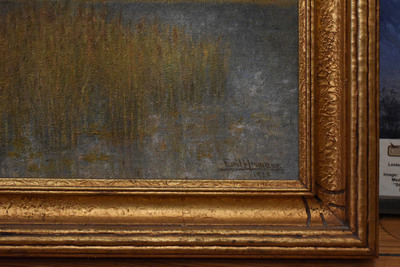-
Emil Hermann (1871 - 1966)
-
Paintings
-
- Emil Hermann
- (1871 - 1966)
- Austria, Ohio, Wichita Falls (Texas) Artist
- Size: 47.5 x 36
- Frame: 54.5 x 44
- Medium: Oil
- Dated 1918
- "Sam Houston"
- View details
- Contact for Price & Info
-
- Emil Hermann
- (1871 - 1966)
- Austria, Ohio, Wichita Falls (Texas) Artist
- Size: 25 x 30
- Frame: 30 x 35
- Medium: Oil on canvas
- 1928
- "Sunset and Moon Rise"
- View details
- Contact for Price & Info
-
-
Biography
Emil Hermann (1871 - 1966) Austria, Ohio, Wichita Falls (Texas) Artist
Emil Hermann
(Am.1871-1966)
Emil Hermann was born in Vienna of French and Austrian parents. His father was an engineer who did not consider art a proper profession for a young man. But so obvious was Hermann's talent, that his father let him enter the Royal Academy in Vienna. He went on to study at the National Art Institute at Budapest and the Rembrandt Art Institute in Amsterdam. In 1889, Hermann came to the United States to study at the Pennsylvania Academy of Fine Arts at the age of nineteen.
Hermann was the organizer and first president of the Ohio Brush and Pencil Club and president of the Dayton, Ohio Art Club. As a result of his work in the latter city, a two-million-dollar art center was later founded there.
After enrolling in the Academy, he opened his first studio in Philadelphia. In 1890, he received his citizenship papers.
His first break came when a Dayton art dealer invited Hermann to hold a one-man art show. From this show, he obtained a position as a muralist with the great Schachne Studios. Soon, he became one of the best-known portrait artists in the area, drawing the leading citizens of Dayton to his studio.
The upcoming artist was such a success that, soon, he was traveling throughout the country to execute portrait commissions and hold exhibitions. On one such trip, he was in Tulsa. After viewing his exhibition, a group of Missouri attorneys, some of whom were living in Oklahoma, commissioned Hermann to paint a portrait of General John H. Pershing from an only existing photograph that had been made in France.
This work, when completed, was presented to the Missouri Historical Society in St. Louis, and he was later commissioned to duplicate the portrait for the city of Loclede, Missouri, the birthplace of General Pershing.
At a suggestion from his Tulsa friends, Hermann opened an exhibit on the balcony of the Freer Furniture Company, at Ninth and Scott in Wichita Falls, in 1919, in the midst of the great Burkburnett oil boom.
Mr. and Mrs. J.A. Kemp commissioned him to do a portrait, which now hangs in the Kemp Public Library. As a result of this show his fame spread and he was soon flooded with offers from all parts of the southwest. The Fort Worth citizens club gave him a commission to do a portrait of Teddy Roosevelt for a memorial.
Until 1932, Hermann's time was divided between Wichita Falls and Dayton. He spent the winter and spring in Wichita Falls and the summers in Ohio. In 1933, he sold his Dayton home and established a permanent home and studio in Wichita Falls.
Shortly before moving to Wichita Falls, Hermann married Minnie Roberts in 1919, who died in 1951.
The years in Wichita Falls were fruitful ones. In 1960, at the age of 90, Hermann told reporters that probably 500 of his works, including 100 portraits, hung in homes and public buildings in Texas, Louisiana, and Oklahoma.
Emil Hermann died in his studio in Wichita Falls, Texas in 1966 at the age of 95. His brush captured the likeness of great and ordinary men with equal vigor during his 75-year artistic career. He completed more than 1,000 portraits, murals, and landscapes during his lifetime - many of which grace Texas homes and public buildings, today.
Sources:
Obituary, Wichita Falls Times (May 1, 1966); O'Brien, E.F.Art and Artists of Texas. Dallas:1935





